Funeral of Diana, Princess of Wales
The funeral of Diana, Princess of Wales started on Saturday 6 September 1997 at 9:08am in London, when the tenor bell of Westminster Abbey started tolling to signal the departure of the cortège from Kensington Palace. The coffin was carried from the palace on a gun carriage, along Hyde Park to St. James's Palace, where Diana's body had remained for five days before being taken to Kensington Palace.[1] The Union Flag on top of the palace was lowered to half mast.[2] The official ceremony was held at Westminster Abbey in London and finished at the resting place in Althorp.[3]
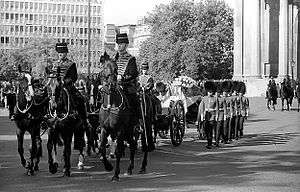 The funeral cortège passing the Wellington Arch on Hyde Park Corner | |
| Date | 6 September 1997 |
|---|---|
| Time | 9:08–15:32 BST (UTC+01:00) |
| Duration | 384 minutes |
| Venue | Westminster Abbey, London |
| Coordinates | 51°29′58″N 00°07′39″W |
| Type | Royal ceremonial funeral |
| Participants | British royal family Spencer family BBC Singers Lynne Dawson Tony Blair Elton John |
Two thousand people attended the ceremony in Westminster Abbey[4] while the British television audience peaked at 32.10 million, one of the United Kingdom's highest viewing figures ever.[5] An estimated 2.5 billion people watched the event worldwide,[6][7] making it one of the biggest televised events in history.
Funeral
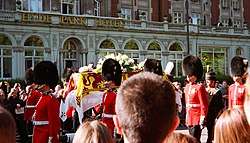
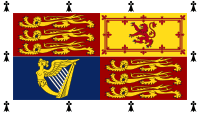
Diana's coffin, draped with the royal standard with an ermine border (i.e. the Other Members' standard), was brought to London from the Salpêtrière Hospital, via Vélizy – Villacoublay Air Base, Paris, by Diana's former husband Charles, Prince of Wales and her two sisters on 31 August 1997.[8] After being taken to a private mortuary it was put at the Chapel Royal, St James's Palace.[8] The funeral plan for the Queen Mother, codenamed Operation Tay Bridge, had been rehearsed for 22 years and was used as the basis for Diana's funeral.[9]
The event was not a state funeral, but a royal ceremonial funeral including royal pageantry and Anglican funeral liturgy.[10] A large display of flowers was installed at the gates of Kensington Palace and Buckingham Palace. Eight members of the Queen's Welsh Guards accompanied Diana's coffin, draped in the royal standard with an ermine border, on the one-hour-forty-seven-minute ride through London streets. On top of the coffin were three wreaths of white flowers from her brother, the Earl Spencer, and her sons, Prince William and Prince Harry.[11][12] There was also a letter from Prince Harry on her coffin addressed to "Mummy".[13] At St. James's Palace, the Duke of Edinburgh, the Prince of Wales, her sons, and her brother joined to walk behind.[14] Five hundred representatives of various charities the Princess had been involved with joined behind them in the funeral cortege.[15] The coffin passed Buckingham Palace where members of the Royal Family were waiting outside. Queen Elizabeth II bowed her head as it went by.[16] More than one million people lined the streets of London, and flowers rained down onto the cortège from bystanders.[11][17][18]
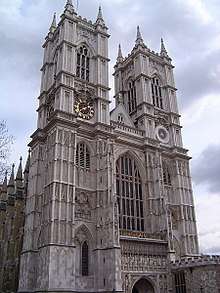
The ceremony at Westminster Abbey opened at 11:00 BST and lasted one hour and ten minutes. The royal family placed wreaths alongside Diana's coffin in the presence of former British Prime Ministers John Major, Margaret Thatcher, James Callaghan and Edward Heath, and former Conservative MP Winston Churchill, the grandson of World War II-era Prime Minister Sir Winston Churchill.[19] International guests included Sir Cliff Richard, US First Lady Hillary Clinton and former Secretary of State Henry Kissinger, William J. Crowe, French First Lady Bernadette Chirac, Queen Noor of Jordan, Tom Hanks, Steven Spielberg, Sir Elton John, George Michael, Chris de Burgh, Michael Barrymore, Mariah Carey, Richard Branson, Luciano Pavarotti, Tom Cruise, Nicole Kidman, and Richard Attenborough.[19][20][21] The Prime Minister Tony Blair read an excerpt from First Epistle to the Corinthians, Chapter 13: "And now abideth faith, hope, love, these three; but the greatest of these is love".[22] Among other invitees were the King of Spain, Princess Margriet of the Netherlands, King Constantine II of Greece, the Crown Prince and Crown Princess of Japan, and South Africa president Nelson Mandela.[23]
Bernie Taupin on writing the lyrics for "Candle in the Wind 1997"[24]
The Archbishop of Canterbury George Carey and the Dean of Westminster Wesley Carr were also present in the abbey. The Anglican service opened with the traditional singing of "God Save the Queen". Pieces by Johann Sebastian Bach, Antonín Dvořák, Camille Saint-Saëns, Gustav Holst, Giuseppe Verdi and other composers were played throughout the ceremony.[25]
During the service, Elton John sang "Candle in the Wind" which had been re-written in tribute to Diana.[26] He had contacted his writing partner Bernie Taupin, asking him to revise the lyrics of his 1973 song "Candle in the Wind" to honour Diana, and Taupin rewrote the song accordingly.[24][25] Only a month before Diana's death she had been photographed comforting John at the funeral of their mutual friend Gianni Versace.[27][28]
Diana's brother Charles gave the eulogy, in which he rebuked both the royal family and the press for their treatment of his sister.[29][30] "It is a point to remember that of all the ironies about Diana, perhaps the greatest was this – a girl given the name of the ancient goddess of hunting was, in the end, the most hunted person of the modern age," Spencer said during his speech.[31]
"Song for Athene" by British composer John Tavener, with text by Mother Thekla, a Greek Orthodox nun, drawn from the Orthodox liturgy and Shakespeare's Hamlet, was sung by the Westminster Abbey Choir conducted by Martin Neary as Diana's cortège departed from the main nave of Westminster Abbey.[25] This was followed after a one minute silence by half-muffled change ringing on the Abbey's ten bells. On the same day, a memorial service was held at Washington National Cathedral and was attended by 2,170 people including the British ambassador John Kerr, the U.S. ambassador to the United Nations Bill Richardson, and chairman of The Washington Post Co. executive committee Katharine Graham.[32] On Sunday, 7 September, an additional service for Diana was performed at Westminster Abbey in response to popular demand.[33]
Television coverage of the funeral was watched by 31 million people in the United Kingdom, making it the most watched live broadcast to date.[34] The world-wide television audience for the event has been estimated at 2.5 billion people.[35]
Burial
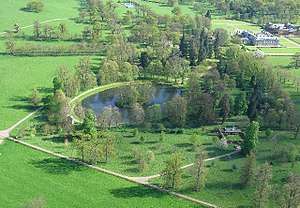
The burial occurred privately later the same day. Diana's former husband, sons, mother, siblings, a close friend, and a clergyman were present. Diana's body was clothed in a black long-sleeved, three-quarter length woolen cocktail dress designed by Catherine Walker which she had chosen some weeks before and a pair of black shoes. A set of rosary beads was placed in her hands, a gift she had received from Mother Teresa, who died the same week as Diana. In her hands there was also a photograph of her sons, a photo which travelled around with her and had been found in her handbag.[36] Paul Burrell reportedly also took some pictures of Prince Harry and Prince William from under her glass dressing table from her Kensington Palace apartment and put them in her coffin as well.[37] Her grave is on an island (52.283082°N 1.000278°W) within the grounds of Althorp Park, the Spencer family home for centuries.[38] The ground was consecrated by the Bishop of Peterborough prior to the burial.[39]
At the ceremony, the Royal Standard which had covered the coffin was removed by Diana's brother moments before she was buried, and replaced with the Spencer family flag; the Earl claimed that "She (Diana) is a Spencer now." Princes Charles, William and Harry agreed to the change. However, Paul Burrell, Diana's former butler, condemned the move, telling the Daily Mirror that "It had more to do with his Spencer v Windsor war than doing what Diana would have wanted. It was inappropriate and disrespectful. I knew it was not what Diana would have wanted. With that act, her brother was depriving the Princess of her proper status in life – a status of which she was proud." Earl Spencer called Burrell's comments "hurtful lies" and said in a statement: "The Queen's standard was removed as part of the ceremony by her own officer in a dignified and pre-agreed manner".[40][41]
The original plan was for Diana to be buried in the Spencer family vault at the local church in nearby Great Brington, but Lord Spencer said that he was concerned about public safety and security and the onslaught of visitors that might overwhelm Great Brington. He decided that Diana would be buried where her grave could be easily cared for and visited in privacy by William, Harry, and other Spencer relatives.[42]
The island is in an ornamental lake known as The Round Oval within Althorp Park's gardens.[43] A path with thirty-six oak trees, marking each year of her life, leads to the Oval. Four black swans swim in the lake. In the water there are water lilies, which, in addition to white roses, were Diana's favourite flowers. On the southern verge of the Round Oval sits the Summerhouse, previously in the gardens of Admiralty House, London, and now adapted to serve as a memorial to Diana.[44] An ancient arboretum stands nearby, which contains trees planted by the family.[42] The Spencer family's decision to bury the Princess in this secluded—and private—location has enabled them to visit her grave in private.[45]
The burial party was provided by the 2nd Battalion The Princess of Wales's Royal Regiment, who were given the honour of carrying the Princess across to the island and laying her to rest. Diana was the Regiment's Colonel-in-Chief from 1992 to 1996.[46]
References
- "Diana's Coffin Moved Amid Emotional Scenes". BBC. Archived from the original on 27 May 2018. Retrieved 16 March 2018.
- Balz, Dan (5 September 1997). "Queen Orders Flags At Half-Staff At Palace". Washington Post. Archived from the original on 1 May 2018. Retrieved 17 March 2018.
- "Diana, Princess of Wales". Westminster Abbey. Archived from the original on 15 May 2018. Retrieved 14 May 2018.
- Chang, Suna; Holmes, Anna (26 December 1997). "Take a look back at Princess Diana's impact on 1997". Entertainment Weekly. Archived from the original on 1 January 2014. Retrieved 14 May 2018.
- "Tracking 30 years of TV's most watched programmes" Archived 2015-01-18 at the Wayback Machine. BBC. Retrieved 20 January 2015
- John Urry. Global complexity, Wiley-Blackwell, 2003 p. 134
- "World Remembers Diana". BBC. Archived from the original on 22 August 2018. Retrieved 25 May 2018.
- "Princess Diana's body comes home". CNN. 31 August 1997. Archived from the original on 4 March 2016. Retrieved 23 July 2013.
- Knight, Sam (17 March 2017). "'London Bridge is down': the secret plan for the days after the Queen's death". The Guardian. Archived from the original on 27 May 2019. Retrieved 10 November 2017.
- Paul D. L. Avis. A church drawing near: spirituality and mission in a post-Christian culture, Continuum International Publishing Group, 2003
- "Diana 1961–1997: The Cortege – A flower-strewn path leading to the Abbey" Archived 2015-09-25 at the Wayback Machine. The Independent. Retrieved 8 June 2012
- "World watches as Britain bids farewell to Diana" Archived 2014-01-01 at the Wayback Machine. CNN. Retrieved 8 June 2012
- "1997: Diana's funeral watched by millions". BBC. Archived from the original on 1 August 2017. Retrieved 29 May 2018.
- MacQueen, Ken (23 May 2012). "How Diana damaged William". MacLean's. Archived from the original on 1 January 2014. Retrieved 1 June 2013.
- "The Final Journey – The Procession". BBC. Archived from the original on 2 October 2018. Retrieved 25 May 2018.
- "The Last Journey Begins" Archived 2016-10-12 at the Wayback Machine. BBC. Retrieved 8 June 2012
- "Diana: Sights and Sounds – The Funeral" Archived 2012-02-14 at the Wayback Machine. BBC. Retrieved 8 June 2012
- "Crowds Say Final Farewell to Diana". BBC. Archived from the original on 6 November 2018. Retrieved 25 May 2018.
- "Special Report: Princess Diana, 1961–1997". Time. 6 September 1997. Archived from the original on 14 September 2000. Retrieved 14 May 2018.
- Joal Ryan (6 September 1997) Farewell, "Mummy": Princess Diana's Funeral Archived 2020-03-15 at the Wayback Machine E!online
- "Celebrities attend Diana funeral". United Press International. 6 September 1997. Archived from the original on 15 January 2019. Retrieved 21 January 2019.
- Brian MacArthur. Requiem: Diana, Princess of Wales 1961–1997 – Memories and Tributes, Arcade Publishing, 1998, p. 165
- Roberts, Roxanne (5 September 1997). "A Hot Ticket for a Sad Occasion". Washington Post. Archived from the original on 10 September 2017. Retrieved 14 May 2018.
- "The songwriters idea book". Writer's Digest Books p.103. Archived from the original on 20 April 2017. Retrieved 13 March 2016.
I thought it was very important to project it from a nation's standpoint. I wanted to make it sound like a country singing it. From the first couple of lines i wrote [which began "Goodbye England's Rose"], the rest sort of fell into place.
- "The Funeral Service of Diana, Princess Wales: Order of Service". BBC. 6 September 1997. Archived from the original on 26 September 2018. Retrieved 20 June 2018.
- Barry Miles (2008). "Massive Music Moments" Archived 2014-07-10 at the Wayback Machine p. 207. Anova Books, 2008
- The Advocate 14 Oct 1997 Archived 2017-04-19 at the Wayback Machine Retrieved 25 December 2010
- Fred Bronson The Billboard book of number one hits p. 860. Billboard Books, 1997
- "Diana's Brother Pledges to Protect Royal Princes". BBC. Archived from the original on 16 April 2017. Retrieved 25 May 2018.
- "Prince William's uncle Earl Spencer set to wed". BBC. 15 February 2011. Archived from the original on 30 November 2017. Retrieved 27 May 2013.
- "Full text of Earl Spencer's Funeral Oration". BBC. Archived from the original on 29 May 2017. Retrieved 14 May 2018.
- Hill, Retha (6 September 1997). "Washington Says Goodbye to Diana". The Washington Post. Archived from the original on 8 July 2018. Retrieved 25 May 2018.
- Evans, Margaret (1998). "The Diana Phenomenon: Reaction in the East Midlands". Folklore. 109 (1–2): 101–103. doi:10.1080/0015587X.1998.9715967.
- Jones, Ian (6 September 2017). "Princess Diana's funeral is most-watched live TV event". www.sundaypost.com. The Sunday Post - DC Thompson Co Ltd. Archived from the original on 24 May 2019. Retrieved 24 May 2019.
- "Some 2.5 billion TV viewers watch Princess Diana's funeral". www.history.com. A&E Television Networks, LLC. 21 February 2019. Archived from the original on 24 May 2019. Retrieved 24 May 2019.
- MORTON, ANDREW. DIANA, HER TRUE STORY.
- "Diana Wanted to Become America's First Lady, Butler Says". ABC News. Archived from the original on 8 June 2015. Retrieved 15 January 2020.
- "Diana Returns Home". BBC. Archived from the original on 2 December 2010. Retrieved 13 October 2008.
- Arthur, Charles (6 September 1997). "Diana 1961-1997: Journey's end - At peace, at last, Diana comes home". The Independent. Archived from the original on 17 December 2017. Retrieved 29 August 2017.
- "Earl disputes butler 'lies'". BBC. 8 November 2002. Archived from the original on 18 March 2018. Retrieved 17 March 2018.
- Cobain, Ian (9 November 2002). "Earl disputes Burrell's story of Princess's funeral flag". The Times. Archived from the original on 18 March 2018. Retrieved 17 March 2018.
- "Burial site offers princess a privacy elusive in life". Sarasota Herald Tribune. 6 September 1997. Archived from the original on 22 February 2017. Retrieved 1 June 2013.
- "Top 10 Celebrity Grave Sites". Time. 3 September 2009. Archived from the original on 26 August 2013. Retrieved 1 June 2013.
- "Althorp Park, Home of Princess Diana". Britain Express. Archived from the original on 20 December 2017. Retrieved 13 October 2008.
- "Visiting Althorp". Althorp Estate. Archived from the original on 1 July 2018. Retrieved 26 September 2015.
- "Diana, Princess of Wales". 31 August 1997. Archived from the original on 4 October 2015. Retrieved 25 February 2016.
Further reading
- Nigel Dacre. The funeral of Diana, Princess of Wales. Court Historian, 8:1 (2003), 85–90
- Adrian Kear, Deborah Lynn Steinberg. Mourning Diana: nation, culture, and the performance of grief, Routledge, 1999
- Tony Walter. The mourning for Diana, Berg Publishers, 1999
.svg.png)
.svg.png)